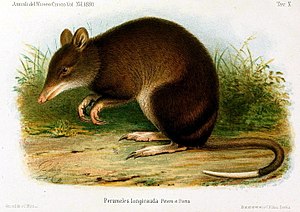Long-tailed mouse-nosed pouch
| Long-tailed mouse-nosed pouch | ||||||||||||
|---|---|---|---|---|---|---|---|---|---|---|---|---|

Long-tailed mouse nasal sac ( Microperoryctes longicauda ) |
||||||||||||
| Systematics | ||||||||||||
|
||||||||||||
| Scientific name | ||||||||||||
| Microperoryctes longicauda | ||||||||||||
| ( Peters & Doria , 1876) |
The long-tailed mouse-nosed bucket ( Microperoryctes longicauda ) is a species of marsupial that occurs with four subspecies, mainly in the central mountains of New Guinea. Microperoryctes longicauda longicauda , the nominate form , lives in the east of the Vogelkop peninsula in the Arfak Mountains , M. l. dorsalis occurs in the Maoke Mountains in western New Guinea, M. l. magnus lives in the southeast of New Guinea and M. l. ornatus occurs in the Bismarck Mountains in eastern New Guinea.
features
The long-tailed mouse nasal sac reaches a head body length of 24 to 30 cm, has a 17.8 to 25.8 cm long tail and weighs 350 to 670 g. This makes the species the largest of all mouse noses. Males and females are the same size. The fur is brown or gray on the back with a more or less reddish tint. Dark longitudinal stripes on the back and sometimes on the head are more pronounced in the east than in the west of the distribution area. The peritoneum is whitish. M. l. longicauda is rather dark gray in color, without any patterns, M. l. dorsalis is a little lighter and more reddish with clear stripes on the back, M. l. ornatus has distinct back stripes and also stripes on the sides of the body and M. l. magnus has a darker peritoneum, is larger than the other subspecies and has a longer tail. Ears and tails of all subspecies are hairless.
Habitat and way of life
The animals live in primary and secondary forests, in mossy mountain forests, in gardens and grass thickets and in alpine regions above the tree line at heights of 1000 to 4000 meters, in the Arfak Mountains possibly also further down. They are completely or partially nocturnal and spend the day in nests made of twigs, moss, fall foliage and leaves, which are flat in the ground, between tree roots or in large tufts of grass. Not much is known about nutrition. The animals are certainly omnivorous and their diet includes insects, other invertebrates, especially worms, small vertebrates and windfalls. Long-tailed mouse-nosed beetles reproduce all year round. One to four young animals are born per litter.
Danger
The IUCN lists the long-tailed mouse-nosed pouch as "not endangered" (least concern) because of its wide distribution area. However, it is not known whether the population is decreasing. In densely populated areas, the species could suffer from high hunting pressure. Feral dogs are also dangerous to her. The status of the individual subspecies is not known. M. l. magna , which has a small, densely populated area of distribution, could be endangered.
Individual evidence
- ↑ a b c d Christopher Dickman: Family Peramelidae (Bandicoots and Echymiperas). in Don E. Wilson , Russell A. Mittermeier : Handbook of the Mammals of the World - Volume 5. Monotremes and Marsupials. Lynx Editions, 2015, ISBN 978-84-96553-99-6 , page 397.
- ↑ Microperoryctes longicauda in the Red List of Threatened Species of the IUCN 2016. Posted by: Leary, T., Wright, D., Hamilton, S., Singadan, R., Menzies, J., Bonaccorso, FJ, Helgen, K., Seri, L., Aplin, K., Dickman, C. & Salas, L., 2016. Retrieved August 22, 2018.
